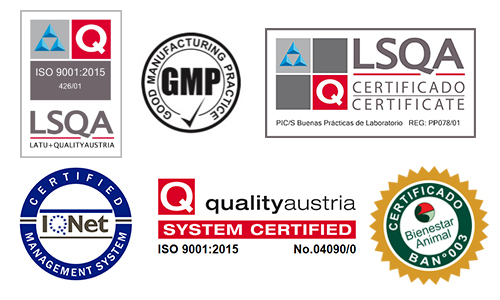Contacto y ubicación
Laboratorios Microsules Uruguay S.A.
Ruta 101 Km 28, Cno. Al Paso Escobar s/n,
Canelones, Uruguay. C.P. 91001.
Tel.: (00598) 2 288 6761
Fax.: (00598) 2 288 6760
info@laboratoriosmicrosules.com
Certificados

Formula:
Each 100 mL contains:
Oxytetracycline dihydrate (*) 32.4 g
Flunixin meglumine (**) 3.3 g
Excipients q.s.ad. 100.0 mL
(*) equivalent to 30 g Oxytetracycline
(**) equivalent to 2 g Flunixin base
Indications:
Synergic association of a wide spectrum and long-acting antibiotic (Oxytetracycline L.A) with a non-steroid analgesic (Flunixin), analgesic and antipyretic with anti-endotoxic effect for 24 to 36 hours, to optimize the treatment in a single application.
Oxytetracycline: to promote a lasting and sustained action for the control and treatment of infectious conditions of the respiratory and urinary systems and local infections caused by Gram positive and Gram negative germs.
Flunixin: for infections when an anti-inflammatory, antipyretic and anti-endotoxic effect is required. Treatment for inflammation of locomotive apparatus and musculoskeletal system. It is also used in inflammatory conditions associated to the “Bovine Respiratory Complex” due to its antipyretic action. Neonatal diarrhea, downer cow syndrome and for treatment of acute mastitis.
Target species:
Bovine, camelids and South American camelids.
Withdrawal period:
Do not administer in dairy females whose milk is intended for human consumption.
Do not slaughter animals whose meat is intended for human consumption until the following time periods have elapsed:
Route of administration:
It is administered through deep intramuscular parenteral route, preferably in the neck area (neck side area). Do not administer more than 10 mL per inoculation site.
Dosage:
Suggested posology: 10 mL every 100 kg l.w. every 5 to 7 days (equivalent to 30 mg/kg of l.w. of oxytetracycline and to 2 mg/kg of l.w. of flunixin).
Dose: 10 mL every 150 kg l.w. for mild infections; 10 mL every 100 kg l.w. for moderate to severe infections.
The interval may vary according to the needs in each case and/or at veterinarian’s discretion.
Laboratorios Microsules Uruguay S.A.
Ruta 101 Km 28, Cno. Al Paso Escobar s/n,
Canelones, Uruguay. C.P. 91001.
Tel.: (00598) 2 288 6761
Fax.: (00598) 2 288 6760
info@laboratoriosmicrosules.com
